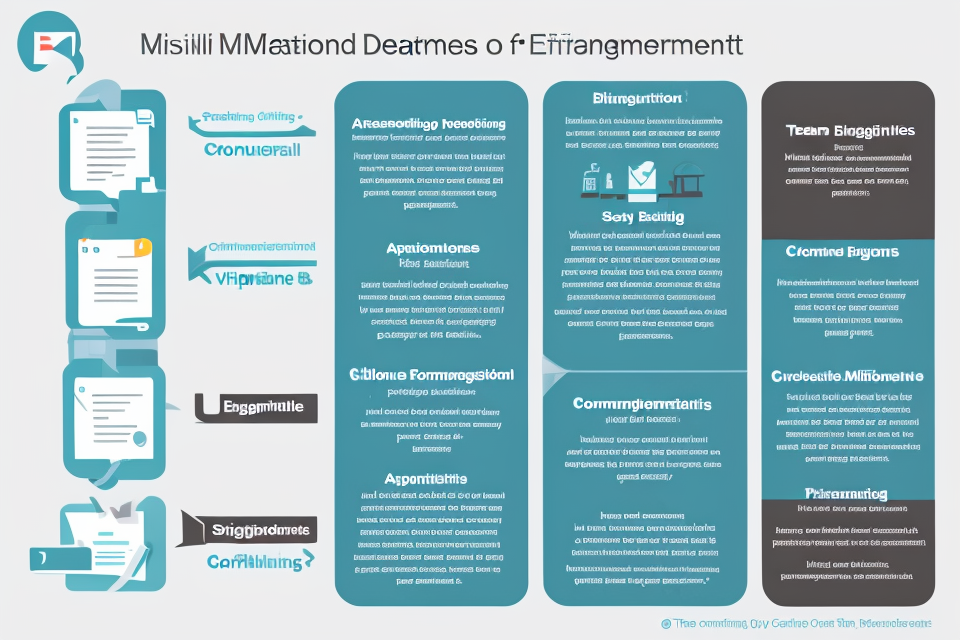DIDs, or Debt Issuance and Debt Servicing, are essential components of corporate finance. They allow companies to manage their financial resources effectively and efficiently. In this comprehensive guide, we will explore the various uses of DIDs in management, including their role in raising capital, managing risk, and optimizing financial performance. Whether you’re a seasoned finance professional or just starting out, understanding the basics of DIDs is crucial to your success in the world of finance. So, let’s dive in and discover the exciting world of DIDs!
What are DIDs?
Definition and Overview
- Definition of DIDs
DIDs, or “dissociative identity disorder,” is a complex mental health condition characterized by the presence of two or more distinct identities or personality states within an individual. These identities are typically accompanied by amnesia or a lack of memory for important information about the person’s life.
- How DIDs work
DIDs typically develop as a result of significant trauma or abuse in a person’s life, which leads to the formation of different identities as a coping mechanism. These identities can have their own distinct memories, beliefs, and behaviors, and the person may switch between them involuntarily or at will.
- Key components of DIDs
Some of the key components of DIDs include:
- Dissociation: The process of disconnecting from one’s thoughts, feelings, and memories. This is a coping mechanism that allows individuals with DIDs to escape from overwhelming experiences or emotions.
- Amnesia: A lack of memory for important information about one’s life, often including events, people, and even personal details. This amnesia can be localized to specific identities or be more general.
- Multiple identities: The presence of two or more distinct identities or personality states within an individual. These identities may have their own distinct memories, beliefs, and behaviors, and may communicate with each other or with the outside world in different ways.
- Switching: The process of moving from one identity to another. This can be involuntary or at will, and may be triggered by specific events or situations.
Differences between DIDs and other Identification Numbers
IINs
Individual Taxpayer Identification Numbers (ITINs) are identification numbers issued by the Internal Revenue Service (IRS) to individuals who are not eligible for a Social Security Number (SSN). ITINs are used for tax purposes only and are not considered a form of identification for other purposes.
SSNs
Social Security Numbers (SSNs) are issued to U.S. citizens, permanent residents, and temporary residents who are authorized to work in the United States. SSNs are used for a variety of purposes, including filing taxes, opening bank accounts, and obtaining credit.
TINs
Taxpayer Identification Numbers (TINs) are used to identify taxpayers and are issued by the IRS. TINs include SSNs, ITINs, and Employer Identification Numbers (EINs), which are issued to businesses.
DIDs, on the other hand, are not used for tax purposes and are not issued by the IRS. DIDs are unique identifiers assigned to a device on a network, and are used to identify and manage the device’s activities. DIDs are used in a variety of contexts, including device management, security, and data analytics.
Applications of DIDs
Business Use Cases
Tax Compliance
Tax compliance is a critical aspect of running a business, and DIDs can play a significant role in ensuring that businesses are meeting their tax obligations. DIDs can be used to automatically calculate and remit tax payments, generate accurate financial reports, and keep track of changes in tax laws and regulations. This not only saves time and reduces the risk of errors, but also ensures that businesses are in compliance with all relevant tax laws and regulations.
Payroll Processing
Payroll processing is another area where DIDs can provide significant benefits to businesses. DIDs can automate the calculation of employee salaries and benefits, generate pay stubs and tax forms, and manage employee records and payroll tax filings. This reduces the risk of errors and saves time, allowing businesses to focus on more strategic activities.
Vendor Management
Vendor management is a critical aspect of managing a business, and DIDs can help businesses manage their vendor relationships more effectively. DIDs can be used to manage vendor contracts, track vendor performance, and generate reports on vendor spending. This helps businesses to identify potential issues early and take corrective action before they become more serious problems.
In addition to these specific use cases, DIDs can also be used in a variety of other business functions, such as inventory management, customer relationship management, and supply chain management. By automating and streamlining these processes, DIDs can help businesses to improve their efficiency and productivity, allowing them to focus on their core business activities.
Individual Use Cases
DIDs or Decentralized Identifiers are a type of digital identity that are stored on a blockchain, allowing for decentralized management and control. These identifiers are used to establish the ownership and authenticity of digital assets and data.
One of the key use cases for DIDs is in the area of personal identification. DIDs can be used to verify a person’s identity in a decentralized manner, without the need for a central authority or intermediary. This can be particularly useful in situations where traditional identification methods may not be available or may not be trusted.
Another use case for DIDs is in access control. DIDs can be used to establish a person’s identity and verify their permissions to access certain resources or data. This can be particularly useful in situations where there is a need to control access to sensitive information or resources.
DIDs can also be used in banking and financial transactions. By providing a secure and decentralized means of verifying a person’s identity, DIDs can be used to facilitate secure and efficient financial transactions. This can be particularly useful in situations where traditional identification methods may not be available or may not be trusted.
Overall, DIDs offer a promising solution for a wide range of individual use cases, providing a secure and decentralized means of verifying identity and establishing ownership and authenticity of digital assets and data.
Government Use Cases
- Improved Efficiency in Social Welfare Distribution
- DIDs can be used to create a decentralized system for distributing social welfare benefits, making the process more efficient and transparent.
- The use of smart contracts ensures that funds are disbursed automatically and transparently, reducing the need for manual intervention and the potential for fraud.
- DIDs can also help to verify the identity of recipients, ensuring that only eligible individuals receive benefits.
- Streamlined Benefits Administration
- DIDs can be used to automate the administration of benefits, reducing the workload on government employees and improving the accuracy of benefit payments.
- Smart contracts can be used to automate the calculation of benefits, reducing the potential for errors and fraud.
- DIDs can also be used to verify the identity of beneficiaries, ensuring that benefits are paid to the correct individuals.
- Enhanced Healthcare Services
- DIDs can be used to create a decentralized system for managing healthcare services, making it easier for patients to access care and for healthcare providers to coordinate services.
- DIDs can be used to verify the identity of patients, ensuring that their medical records are kept secure and confidential.
- Smart contracts can be used to automate the payment of healthcare bills, reducing the administrative burden on healthcare providers and patients.
Advantages of Using DIDs
Improved Security
One of the key advantages of using DIDs (Decentralized Identifiers) is improved security. Here are some of the ways in which DIDs can enhance security:
- Reduced risk of identity theft: DIDs provide a more secure way of managing identity information compared to traditional methods. By using DIDs, individuals can maintain control over their personal information, reducing the risk of identity theft. This is because DIDs are decentralized, meaning that they are not controlled by any single entity, making it more difficult for hackers to access sensitive information.
- Enhanced privacy: DIDs also provide enhanced privacy by allowing individuals to control who has access to their personal information. This is achieved through the use of encryption and other security measures, which help to protect sensitive data from unauthorized access.
- Better control over personal information: With DIDs, individuals have better control over their personal information. This is because DIDs allow for the creation of decentralized identities that are self-sovereign, meaning that individuals have full control over their personal information. This gives individuals greater control over who has access to their personal information and how it is used.
Overall, DIDs offer a more secure and private way of managing personal information compared to traditional methods. By using DIDs, individuals can reduce the risk of identity theft, enhance their privacy, and have better control over their personal information.
Increased Efficiency
Streamlined processes
DIDs can streamline processes by automating routine tasks and reducing the need for manual intervention. This leads to a reduction in errors and a significant increase in efficiency.
Simplified compliance
DIDs can simplify compliance by providing a centralized platform for managing regulatory requirements. This reduces the risk of non-compliance and ensures that all necessary regulatory requirements are met.
Automated workflows
DIDs can automate workflows, enabling businesses to automate repetitive tasks and free up resources for more critical activities. This leads to a significant increase in efficiency and productivity. Additionally, automated workflows can reduce the risk of errors and improve the accuracy of business processes.
Enhanced Interoperability
DIDs or Decentralized Identifiers play a crucial role in enhancing interoperability between different systems. Interoperability refers to the ability of different systems to communicate and share data seamlessly. In the context of DIDs, interoperability means that DIDs can be used to identify and verify digital assets, identities, and transactions across different platforms and networks.
Standardized identification system
One of the key advantages of DIDs is that they provide a standardized identification system. This means that DIDs can be used to identify and verify digital assets, identities, and transactions in a consistent and reliable manner. DIDs are based on a decentralized architecture, which means that they are not controlled by any single entity. Instead, they are managed by a decentralized network of nodes, which ensures that they are tamper-proof and resistant to censorship.
Improved data sharing
Another advantage of DIDs is that they enable improved data sharing between different systems. With DIDs, digital assets and identities can be verified and authenticated in a decentralized manner. This means that data can be shared between different systems without the need for intermediaries. This not only reduces the risk of fraud and errors but also improves the efficiency of data sharing processes.
Reduced dependency on physical documents
DIDs also help to reduce the dependency on physical documents. With DIDs, digital assets and identities can be verified and authenticated in a decentralized manner. This means that physical documents such as passports, driver’s licenses, and other forms of identification can be replaced by digital DIDs. This not only reduces the risk of fraud and errors but also makes it easier to manage and update digital identities in real-time.
Overall, DIDs offer a number of advantages in terms of enhanced interoperability. They provide a standardized identification system, enable improved data sharing, and reduce the dependency on physical documents. These advantages make DIDs an attractive option for managing digital assets, identities, and transactions in a decentralized and secure manner.
Challenges and Limitations of DIDs
Adoption and Implementation Challenges
Legacy System Compatibility
One of the primary challenges of adopting and implementing DIDs is ensuring compatibility with existing legacy systems. Many organizations have invested heavily in traditional identity and access management solutions, which may not be compatible with DIDs. As a result, integrating DIDs with these legacy systems can be complex and time-consuming, requiring significant technical expertise and resources.
Employee Training and Awareness
Another challenge is providing adequate training and awareness programs for employees. DIDs are a relatively new technology, and many employees may not be familiar with their capabilities or benefits. Organizations need to invest in training programs that educate employees about DIDs, their benefits, and how they can be used to improve security and efficiency.
Vendor Support and Integration
Finally, organizations may face challenges when it comes to vendor support and integration. DIDs are a relatively new technology, and there may be limited vendor support available. This can make it difficult for organizations to find vendors who can provide the necessary support and integration services. Additionally, integrating DIDs with existing systems may require custom development work, which can be time-consuming and expensive.
Privacy and Security Concerns
DIDs (Decentralized Identifiers) are digital identifiers that are designed to be more secure and private than traditional identifiers. However, despite their benefits, DIDs also come with some challenges and limitations, particularly in terms of privacy and security.
One of the main privacy and security concerns associated with DIDs is centralized data storage. DIDs rely on a decentralized network of validators to verify the authenticity of a digital identity. However, this decentralized network of validators is still centralized in terms of where the data is stored. This means that all of the data associated with a DID is stored in a central location, making it vulnerable to cyber attacks and data breaches.
Another concern is the vulnerability to cyber attacks. Because all of the data associated with a DID is stored in a central location, it is vulnerable to cyber attacks that could compromise the privacy and security of the data. For example, if a hacker were to gain access to the centralized data storage, they could potentially access and steal the data associated with all of the DIDs stored there.
Lastly, there is the concern of unauthorized access. Since all of the data associated with a DID is stored in a central location, it is also vulnerable to unauthorized access. This means that even if a hacker does not gain access to the centralized data storage, there is still a risk that someone could gain unauthorized access to the data.
Overall, the privacy and security concerns associated with DIDs are significant. However, these concerns can be mitigated through the use of appropriate security measures, such as encryption and multi-factor authentication. Additionally, ongoing research and development in the field of DIDs is focused on finding ways to address these concerns and make DIDs even more secure and private.
The Future of DIDs
Emerging Trends and Developments
Digital identity verification
One of the most significant trends in the future of DIDs is the emergence of digital identity verification. With the increasing prevalence of online transactions and digital interactions, the need for secure and reliable methods of verifying one’s identity has become more critical than ever before.
Decentralized identity management
Another emerging trend in the future of DIDs is the development of decentralized identity management systems. These systems are designed to provide individuals with greater control over their personal information and to enable more secure and efficient identity verification processes.
Integration with blockchain technology
Finally, the integration of DIDs with blockchain technology is another emerging trend that holds great promise for the future. By combining the security and transparency of blockchain with the flexibility and interoperability of DIDs, it may be possible to create more secure and efficient identity management systems that can be used across a wide range of applications and industries.
Opportunities and Potential Impact
DIDs, or Decentralized Identifiers, have the potential to revolutionize the way we interact with and use digital services. Here are some of the opportunities and potential impacts of DIDs in the future:
- Enhanced digital experience: With DIDs, users will have greater control over their online identities and data. This means that users can choose which information they share with which parties, and can revoke access to that information at any time. This will result in a more secure and private digital experience for users.
- Greater efficiency and productivity: DIDs will also make it easier for businesses and organizations to communicate and transact with each other. Instead of having to go through intermediaries or centralized authorities, parties can directly communicate with each other and verify each other’s identities using DIDs. This will result in a more efficient and streamlined process, saving time and resources for all parties involved.
- New business models and revenue streams: DIDs will enable new business models and revenue streams that are not possible with traditional centralized systems. For example, DIDs could be used to create decentralized marketplaces or peer-to-peer networks where users can buy and sell goods and services directly with each other, without the need for intermediaries. This could result in a more equitable distribution of value and wealth.
Overall, the potential impact of DIDs on the future of the internet is significant. By enabling greater control, efficiency, and innovation, DIDs have the potential to transform the way we interact with and use digital services.
Recap of Key Points
- Definition and overview of DIDs:
- DIDs (Decentralized Identifiers) are a new type of digital identifier that are designed to be more secure, privacy-preserving, and interoperable than traditional identifiers.
- They are based on distributed ledger technology and are designed to be self-sovereign, meaning that individuals and organizations can control their own identifiers without the need for a central authority.
- Applications of DIDs in business, government, and individual use cases:
- DIDs have the potential to revolutionize the way we prove our identity online, making it easier to securely share personal information with third parties.
- They can be used in a variety of applications, including financial services, healthcare, and supply chain management.
- DIDs can also be used by individuals to control their personal data and identity in a more secure and privacy-preserving way.
- Advantages of using DIDs, including improved security, increased efficiency, and enhanced interoperability:
- DIDs are designed to be more secure than traditional identifiers, as they are based on distributed ledger technology and use cryptographic signatures to prove ownership.
- They can also increase efficiency by reducing the need for third-party intermediaries, such as identity providers.
- DIDs can also improve interoperability by allowing different systems to communicate with each other in a more seamless way.
- Challenges and limitations of DIDs, including adoption and implementation challenges and privacy and security concerns:
- One of the main challenges of DIDs is the need for a common set of standards and protocols to ensure interoperability.
- Another challenge is the need for user education and awareness, as DIDs are a new technology that may be unfamiliar to many people.
- Privacy and security concerns are also a potential challenge, as DIDs require individuals to share personal information with third parties in order to prove their identity.
- Emerging trends and developments in DIDs, including decentralized identity management and integration with blockchain technology:
- One emerging trend in DIDs is the development of decentralized identity management systems, which allow individuals to control their own identifiers without the need for a central authority.
- Another trend is the integration of DIDs with blockchain technology, which can provide a secure and transparent way to manage identity information.
- Opportunities and potential impact of DIDs on various industries and sectors:
- DIDs have the potential to transform a variety of industries and sectors, including financial services, healthcare, and supply chain management.
- They can also provide new opportunities for individuals to control their personal data and identity in a more secure and privacy-preserving way.
FAQs
1. What are DIDs?
DIDs, or Data Integrity Detection codes, are special codes that are used to ensure the integrity of data during transmission. They are added to data files and transmitted along with the data to enable the recipient to verify the authenticity and integrity of the data.
2. Why are DIDs important?
DIDs are important because they provide a way to verify the integrity of data during transmission. This is especially important in situations where data is transmitted over unreliable or insecure networks, as it helps to prevent data corruption or tampering. DIDs can also help to ensure that data is not altered or modified during transmission, which is critical for maintaining the accuracy and reliability of the data.
3. How are DIDs used in data management?
DIDs are used in data management to ensure the integrity of data during transmission. They are typically added to data files before they are transmitted, and the recipient uses the DID to verify the integrity of the data upon receipt. DIDs can also be used to verify the authenticity of data, as they provide a way to confirm that the data has not been tampered with or modified.
4. What are some common types of DIDs?
There are several common types of DIDs, including checksums, hash functions, and digital signatures. Checksums are simple algorithms that are used to detect errors in data transmission, while hash functions are more complex algorithms that are used to ensure the integrity of data. Digital signatures are used to verify the authenticity of data by providing a way to confirm that the data has not been tampered with or modified.
5. How do DIDs help to ensure data security?
DIDs help to ensure data security by providing a way to verify the integrity of data during transmission. This helps to prevent data corruption or tampering, which can compromise the security of the data. DIDs can also help to ensure that data is not altered or modified during transmission, which is critical for maintaining the confidentiality and privacy of the data.



